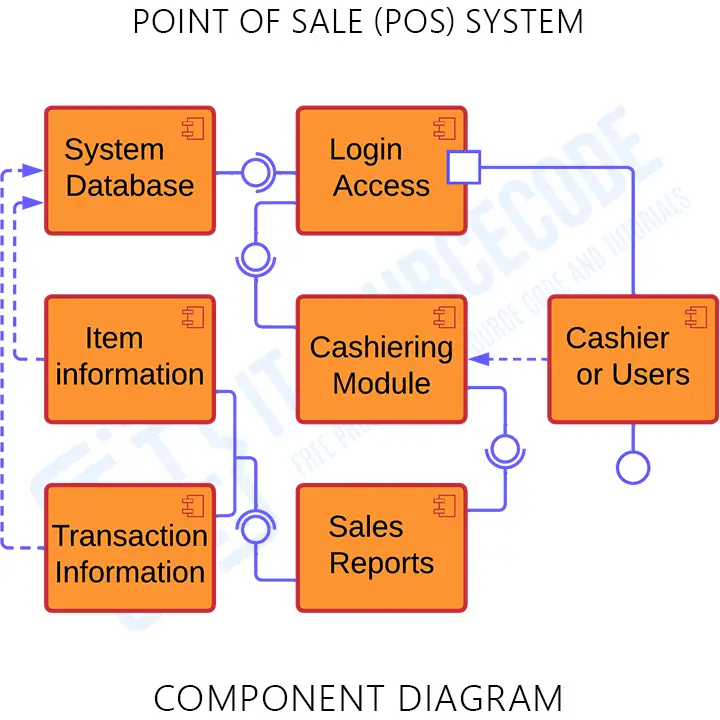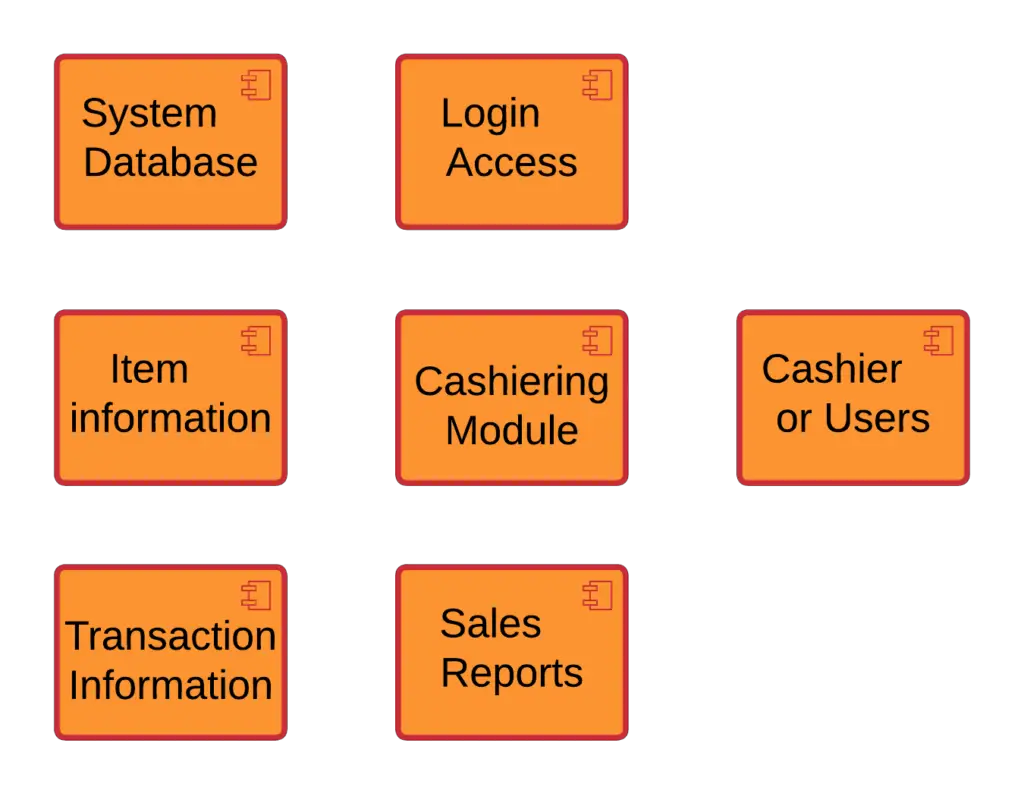Component Diagram for Point of Sale System
The component diagram for point of sale system is used to show how the POS management components work together to make the system operate correctly. This component diagram shows how the software’s parts are organized and how they depend on each other. It gives a high-level look at the parts of a system.
The components of a point of sale system component diagram could be a part of software or hardware. They could be a database, a user interface, or something else that helps the POS system work.
Point of Sale System Component Diagram: Table of contents
- Component Diagram for Point of Sale System
- Component Diagram for Point of Sale System: Details
- What is Point of Sale System?
- Point of Sale System Component Diagram in UML
- The Component Diagram for Point of Sale System
- Point of Sale System Component Diagram (Explanation)
- Point of Sale System Component Diagram Pdf
- Characteristics of Component Diagram:
- Benefits of using Component Diagram
- Steps in Developing Point of Sale System Component Diagram
- Conclusion
- Related Articles:
- Recommended Articles from the Author:
- Inquiries
Component Diagram for Point of Sale System: Details
The table shows the basic details of the component diagram of point of sale system. It has quick description details of the component diagram illustration.
| Name: | Point of Sale System Component Diagram |
| Abstract: | The point of sales (POS) UML component diagram is used in object-oriented programming to group classes together based on their common purpose. This way, the developer and others can see how a project is progressing at a high level. |
| UML Diagram: | Component Diagram |
| Users: | Store or Company Owners and Cashiers. |
| Tools Used: | Diagraming Tools that have UML Component Diagram Symbols |
| Designer: | ITSourceCode.com |
What is Point of Sale System?
A point of sale (POS) system allows your store to take payments from customers and keep track of sales. It may appear straightforward, but depending on whether you sell online, have a physical store, or both, the setup can be difficult. The cashiering management in a store is known as a point-of-sale system.
This POS system combines hardware and software to process sales and payment transactions at the point of sale. It can ring up items by department, track sales, add taxes, and print receipts, among other things. When a purchase or payment is made at a precise point in time in a financial transaction, the point of sale system is activated.
The POS system or software is widely utilized in the restaurant and retail industries. This automated system helps owners to track sales, cash flow, and food inventories, as well as greater ease of transactions and reports.
Point of Sale System Component Diagram in UML
A component diagram in the (UML) Unified Modeling Language shows how parts are wired together to explain the parts of the point of sale system. They are used to show the structure of any kind of system.
The UML component diagram shows how a POS system comprises a set of deployable components, such as dynamic-link library (DLL) files, executable files, or web services. Using well-defined interfaces, these parts communicate with each other and keep their internal details hidden from each other and the outside world.
The Component Diagram for Point of Sale System
This component diagram of point of sales system illustrates the components of every hardware and software node. The component diagram below is a detailed illustration of the Deployment Diagram for Point of Sale System.

This component diagram shows the structure of the POS management, which consists of the software components and their interfaces, user information, and the database. Their dependencies explain how they work together. You can use component diagrams to show how software systems work at a high level, or you can use them to show how each component works at a lower level, or for specifications.
Point of Sale System Component Diagram (Explanation)
The Point of Sale System UML component diagram explains the sketch of the required software and hardware components and the dependencies between them. These components are labeled to clarify their part in the system’s operation. They were represented by symbols that explain their function and role in the overall point of sale operation.
The component diagram of the POS system has 7 components which were the cashier or users, login access, cashiering module, sales reports, system database, item information, and transaction information.
This diagram shows several interfaces that are provided and required. The dependencies on each component are explained through the lines and arrows drawn in the diagram. The required and provided interfaces were declared by the line that has a circle with a semi-circle head.
Point of Sale System Component Diagram Pdf
You may download the Component Diagram PDF file by clicking the button below. It has the full details and discussion of the system’s component diagram. You can also modify its content to complete your project requirements and needs.
Characteristics of Component Diagram:
- In component-based development, they describe systems that have a service-oriented architecture.
- It shows how the code itself looks.
- It can be used to focus on the relationship between the parts while hiding the specifics.
- Help stakeholders understand how the system being built works and how it will be used.
Benefits of using Component Diagram
As complicated as it looks, the component diagram is very important when you’re building your system because it shows how everything works together. Here are the benefits of designing the POS system component diagram:
- Imagine how the system looks in real life.
- Pay attention to the system’s parts and how they work together.
- Pay attention to how the service behaves when it comes to the interface.
Steps in Developing Point of Sale System Component Diagram
Time needed: 10 minutes
Here are the steps in developing the point of sale system component diagram.
- Finalize the Function and Processes of the Software
The first step in developing the component diagram is finalizing the processes and functions of the software. This activity will help programmers analyze the things needed to complete the POS management process. Then the finalized processes or functions will be the base concept in designing the system’s component diagram.
- Put the Components included
A component is a piece of the system that makes sense in terms of logic. It’s a little more abstract than classes. There are tabs or the word “Component” written on top of the name of the component to help you tell it apart from a class.

The component symbol is used for a person or thing that needs to do a stereotype function. It gives and takes behavior through interfaces, as well as through other parts. Components can be grouped into a node or another component and can be only one component. - Add the Dependencies (Ports and interfaces)
A dependency is a relationship in which one component needs the information and services of another component, but not always the other way around. To show that one component is relying on another, you should make a connection.

The component’s port is a feature that indicates where the component and its environment meet. In this picture, ports are shown in small squares on the sides of classifiers. It is created when one thing is needed for another thing to work. There is an “include” statement in the makefile for the component that is dependent on the other component.
Interfaces show how components are wired together and how they work together. When a component needs a certain interface, the assembly connector lets you connect it to another component that already has that interface. It looks like a semi-circle and a line.
A component list contains the set of interfaces that a component can use or realize. Components also need interfaces to do their job. It is part of a system that protects the things inside. They are the parts of a system that make sense and play a big part in how a system works.
Conclusion
You need to know the diagrams used to design and develop the Point of Sale (POS) System. This method is to perfectly create a fully-functional system without unwanted errors and avoid mistakes in development. A component diagram will help you know the components of software and hardware that the project should possess. Not only that, you will find out the needed consideration for the software to work perfectly.
Component diagrams show how a system is put together. During the design phase, software artifacts (classes, interfaces, etc.) of a system are put together into different groups based on how they work together. Now, these groups of things are called parts. Check out our Related and Recommended Articles for more Learning and Information.
Related Articles:
- Component Diagram for Employee Management System
- Component Diagram for Blood Bank Management System
- Component Diagram for Restaurant Management System
- Component Diagram for Payroll System
- Component Diagram for E-commerce Website
Recommended Articles from the Author:
- Point of Sale (POS) System UML Diagrams
- Point of Sales (POS) Class Diagram
- Deployment Diagram for Point of Sale System
- POS (Point of Sale) Activity Diagram
- Point of Sale (POS) System Sequence Diagram
Inquiries
If you have inquiries or suggestions about the discussion and illustration for the Component Diagram for Point of Sale System, just leave us your comments below. We would be glad to hear to concerns and suggestions and be part of your learning.
Keep us updated and Good day!



